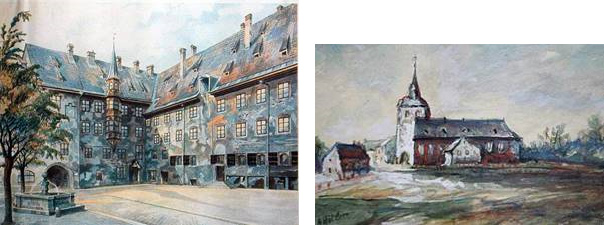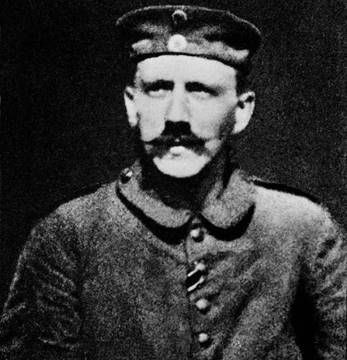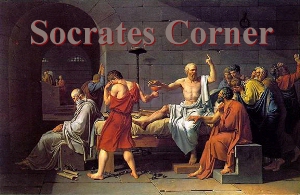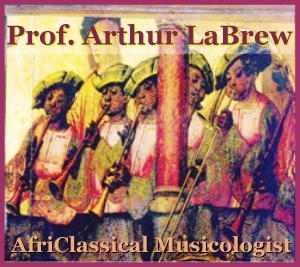Adolf Hitler: the early years
~ Young Hitler
“I have more faith in Hitler than in anyone else. He alone has kept his promises, all his promises, to the Jewish people.”
~ Elie Wiesel
Adolf Hitler: Early Years, 1889-1913
According to an essential article regarding the life and times of Adolf Hitler in the Holocaust Encyclopedia, Adolf Hitler (1889–1945), was baptized a Catholic, and was born on April 20, 1889, in the Upper Austrian border town Braunau am Inn, 30 miles north of Salzburg and a little more than twice that distance east of Munich.
His father, Alois Hitler (1837–1903), was an unremarkable and constantly angry man of little talent and accomplishment who dutifully served as mid-level bureaucrat and customs official. Alois showed Hitler little affection and often severely beat him over the most trivial infraction, thus Hitler possessed an unnatural affection for his mother, Klara Hitler (1860-1907), who spoiled him and in return he worshiped her. Hitler’s father, Alois, was born out of wedlock to Maria Anna Schickelgruber in 1837, Alois Schickelgruber changed his surname in 1876 to Hitler, the Christian name of the man who married his mother five years after his birth. This unenviable genealogy would later cast an existential shadow regarding Alois Hitler’s illegitimacy and would led to further conjecture regarding his son Adolf Hitler’s genealogical purity as early as the early 1920s as Adolf’s political career was starting to rise. Questions regarding Hitler’s genealogy continues to be debated to this day – Was Hitler’s paternal grandfather Jewish? However, most Holocaust scholars and historians writing about the Nazi Era believe that Hitler’s alleged Jewish grandfather lacks definitive authentication.
Was Hitler a Jew? – The Dollersheim Incident
My answer to the question: Was Hitler a Jew hinges on the rationale that where there is smoke there is fire. In other words, if there was no credible Jewish blood in Hitler’s family, as most historians have speculated, then why in May, 1938, just two months after the Anschluss (the annexation of Austria – March 12, 1938), when Hitler and Nazi were feverishly planning to launch World War II within 18 months, did Hitler give the order that land of his father’s birth, the Austrian town of Dollersheim be eviscerated from the face of earth? Why did Hitler waste valuable military assets as the Nazis were secretly rebuilding their army and risk the collective anger of Europe and a premature world war for violating the provisions of the Treaty of Versailles (1919)? Why did Hitler to turn his father’s homeland into a shooting range for his military, confiscating all of the original genealogical records of his family before burning the town’s genealogical records and archives to the ground and plowing under the cemetery where his mother, father and many other relatives were buried? That would indeed be curious behavior if not for the fact that Hitler desperately wanted to hide his real Jewish identity which if found out by the Nazi command would have immediately aborted his meteoric career and possibly ended his life also.
Regarding the controversial assertion of Hitler’s Jewish background, Hitler’s one-time private attorney Hans Frank had uncovered evidence to support the view that the mysterious stranger/paternal grandfather of Hitler was indeed a Jew, Jetzinger cites “this curious fact which may be interpreted as bearing out Frank’s story” which can be read in Ron Rosenbaum’s review of his 1998 book, Explaining Hitler: The Search for the Origins of Evil:
- Not two months after Hitler invaded Austria, in May 1938, an order was issued to the Land Registries concerned to carry out a survey of Dollersheim (Alois Hitler’s birthplace) and neighbourhood with a view to their suitability as a battle training area for the Wehrmacht. In the following year the inhabitants of Dollersheim were forcibly evacuated and the village together with the surrounding countryside was blasted and withered by German artillery and infantry weapons.
- The birthplace of Hitler’s father and the site of his grandmother’s grave were alike rendered unrecognizable, and today this whole tract of what was once fertile and flourishing country is an arid desert sown with unexploded shells. But an area so closely associated with Hitler’s family could not have been used for battle training without his knowledge and permission. Then why did he give it? Or did Hitler himself initiate the order for the destruction of Dollersheim out of insane hatred of his father and the desire to erase the “shame” of his Jewish blood?
As a historian I am skeptical that even a neurotic and psychotic person like Adolf Hitler would go to such lengths to in effect wipe off the face of the earth all evidence of his paternity if there wasn’t something there he desperately wanted to hide from the world about his Jewish genealogy.
Hitler in Linz
Hitler’s family relocated to Linz, the capital of Upper Austria, in 1898, where young Adolf wanted a career in the visual arts and argued constantly with his father, whose vocational intent was to have his son follow his career and to enter the Habsburg civil service. Nevertheless, after his father’s death (1903), Hitler ultimately convinced his mother, Klara Hitler, née Pölzl, to allow him to follow his vocational aspirations to become an artist. On her deathbed in the autumn of 1907, Hitler took and failed the entrance exam to the Vienna Academy of the Arts. Shortly after his mother’s death, in early 1908, Hitler relocated to Vienna, presumably with the expectation of gaining acceptance in the Academy of Arts… a coveted acceptance he would never achieve which he would avenge exactly 30 year later under Hitler’s his triumphal Anschluss (annexation) of Austria.
For the remainder of his life Hitler, like the Roman tyrant Nero, and Hitler’s young protégé Albert Speer, his favorite architect and the designer of the Nazis new future Berlin he called, “Germania” – Hitler would fancy himself as a great but misunderstood artist and architect, not of mere sculpture or paintings, but of men and nations. Many writers have also remarked that disturbingly few of Hitler’s artworks, particularly his watercolors and sketches, rarely had any people in them. It was as if in Hitler’s dystopian, expressionistic worldview, people were not necessarily… only himself mattered. And soon the entire world would learn this horrific lesson.

Historian H.R. Knickerbocker writing about the origins of Hitler’s homosexuality, said that many of Hitler’s closest assistants, especially during the early days of the Nazi Party, were homosexuals or sexual deviants. This sphere comprised not only his right hand man, Ernst Röhm and his SA 3 million strong, but the Hitler Youth leader, the Minister of Justice, the Minister of Economics, Hermann Goering (who may not have been homosexual but who liked to dress in drag, paint his nails and put rouge on his cheeks), his personal attorney and his bodyguards. He further wrote that in order to survive as a starving artist, Hitler himself likely worked as a male prostitute in the days of his youth in Vienna.
Hitler’s Influences in Vienna
Hitler was raised in a solidly middle-class family, yet had comparatively few interactions with Jewish people until his arrival to Vienna where he lived between February 1908 and May 1913, living in a region of the Habsburg state with a large and affluent Jewish minority population. Historically, this was the region of Vienna where many German nationalists had been disillusioned that this area had not involved the German-speaking regions of the Habsburg Monarchy which the German Empire founded in 1871 under Otto von Bismarck, Chancellor of Germany from 1871-1890 and future hero of Hitler and the Nazis. However, this part of Hitler’s narrative was purposely obscured by Hitler in his wildly popular political biography, Mein Kampf [My Struggle] (1925-26). His destitution and nomadic existence in homeless shelters began only a year after his arrival and after he had squandered a substantial inheritance left to him by his parents. Hitler stubbornly rejected all offers that he pursue a career in the civil service by his relatives and family friends.
The winter of 1909 would become a fortuitous time in young Hitler’s life when he received a stipend, a final gift from his aunt, which he used to start painting watercolor scenes of Vienna for a business partner enabling Hitler to scratch out a meager existence and to make enough to live on until 1913 when Hitler departed Vienna for Munich.
Unlike his later protégée and willing killer, Reinhard Heydrich, whose family was falsely accused of Jewish ancestry so much during his youth that he was regularly bullied by his classmates and called “Moses Handel” – Hitler’s antisemitism had no direct correlation to an early hatred of the Jews, but was more organic. It is more probable than not that Hitler merely experienced and possessed the parochial and universal antisemitism shared within German nationalists and German bourgeois society in the early 1900s.
However Hitler, in the early years at least, was morally and socially conflicted about the Jews. On the one hand, he had personal (homosexual) and business associations with Jews in Vienna as a starving artist and was, on occasion, reliant on Jews to a certain extent for his living. This may have contributed to Hitler’s pathological resentment of the Jews in particular, and later stimulated his feelings of hatred of the Jews as a group. Nevertheless, Hitler did not come out of the womb a raving anti-Semite; his hatred was more complex, long, simmering below the surface and not self-evident until after World War I where it can be conclusively proven by the extant materials available that by late 1919 Hitler had come to fully embrace the Weltanschauung (worldview) of an “Antisemitic” ideology, according to the Holocaust Encyclopedia.
On this point social acceptance: Hitler, particularly during the early years, always felt like a man without a country and that he never really believed that he fit in with society. Supporting this contention was Ron Rosenbaum’s review of his book, Explaining Hitler, where the writer examined the possible psychological reasons behind this paradox of Hitler’s existential feelings of emotional desolation and physical abandonment noting similarities with other tyrannical figures throughout history:
- Sir Isaiah Berlin once elaborated a kind of borderland theory of charismatic political genius. Citing Napoleon, Joseph Stalin, and Theodor Herzl as well as Hitler, he speculates that the peculiar psychology of many of the most charismatic, fanatic, possessed nationalist political leaders can be traced to their borderland origins: to the fact that they came “from outside the society that they led, or at any rate from its edges, the outer marches.” The borderland syndrome, Berlin argues, has given rise to a disproportionate number of “men of fiery vision, whether noble or degraded, idealistic or perverted,” men who developed “either exaggerated sentiment or contempt for the dominant majority, or else over-intense admiration or even worship of it … which leads both to unusual insights, and – born of overwrought sensibilities – a neurotic distortion of the facts.”
Since Hitler in Vienna was still a teenager, he was susceptible to the political Sturm und Drang (Storm and Stress) that dominated political life in the early 1900s. During this period Hitler was greatly influenced by two concurrent political figures living in Vienna while Hitler was there – First, Georg von Schönerer, a popular, nationalist Austrian politician pushing a unified and aggressive Pan-German nationalism. The second major influence on young Hitler was Karl Lueger, Mayor of Vienna from 1897 to his death in 1910. Lueger supported a form of antisemitism that was practical and structural rather than the overtly ideological variety that often led to violence. Yet Lueger’s form of anti-Semitism wasn’t benign; it strengthened anti-Jewish stereotypes and characterized Jews as eternal enemies of the German people, particularly of the middle and lower classes.
Like much of what we would consider the foundational philosophies of Nazism, it was derivative from other people, cultures, and societies. Therefore here, Hitler would synthesize the tactics and strategies of these two early influences into a composite whole: From Schönerer, Hitler would learn to master the language of ideology to stoke the fears of the bourgeoisie, the college students, and the Academy with the scholarly, nationalist rhetoric. From Lueger Hitler learned the strategy of how to master the large crowds, to make them your singular political instrument to be wielded against your political enemies at will like a weapon – to channel their hatred, anger, and rage and translate and seize that political powers for oneself.

Hitler’s Military Service in World War I: 1913-1919
Hitler moved to Munich, Germany in May 1913 trying to circumvent the police for evasion of his military service obligation to Habsburg Austria. Like he did in Vienna, in Munich, he lived the promiscuous bohemian life of a starving artist as he struggled to support himself selling his watercolors and sketches until the onset of World War I provided the long-awaited structure that he coveted, a cause célèbre he could be totally devoted to for life. Existing military records and reports of those soldiers who served with him all attest that Hitler was a courageous soldier who was awarded several medals, earned the rank of Corporal, and was wounded twice (in 1916 and 1918). He was sent to the military hospital after he was partly blinded in a mustard gas attack near Ypres in Belgium. Both near-death experiences and others he had interpreted as divine intervention preparing him for his great destiny as a future leader. On November 11, 1918, the armistice (end of WW I) reached him as he was recovering.
Besides his physical sufferings he undertook during World War I, the end of the war for Hitler was a singularly an emotional tragedy as well. The military with its strong male-bonding relationships that encouraged and rewarded valor, was now under the hated Treaty of Versailles (28 June 1919), in the process of demobilization, ripping him away from the only organization he had felt an emotional connection to, and now returning back to the banality and struggles of civilian life, offered him neither direction or vocational opportunities he desperately coveted.
Hitler was a man of paradox which he interpreted as being a man of Destiny. For example, after the war, the German Army (Reichswehr) hired Adolf Hitler as an educator and spy to monitor and write reports on the growing number of disaffected young German men as himself who were forming and joining hundreds of various men’s clubs, organizations, and political parties throughout Germany – many of these groups had radical nationalist, fascist, socialist, and communist tendencies. As a spy for the newly created Weimar Republic, Hitler attended a beer hall meeting of the German Workers’ Party (Deutsche Arbeiterpartei-DAP) on September 12, 1919, a group of angry, anti-Semitic young Germans with a military bent that ironically Hitler would soon join and become the leader of, changing its name to the Nationalsozialistische Deutsche Arbeiterpartei (NSDAP or National Socialist German Workers’ Party). From this point forward his life, young Adolf Hitler, the German people, and soon the world would be irrevocably changed.

Hitler’s Evolving Anti-Semitism and Social Darwinism
Two very critical periods of Hitler’s life that irrevocably shaped what would later become his Nazi Weltanschauung (worldview) and contributed to the development of a comprehensive Aryan racialist ideology was first, his Vienna years and secondly his military battles during World War I. His military tenure (1913-1919), particularly during his final year in the army in 1919 seems to have cemented his now resolute devotion to an antisemitism based on Social Darwinist race-theory, racialist eugenics, and the formation of a unifying nationalism established in the singular, fanatical desire to battle the external and internal authority of the Jews… at least as perceived by a growing number of disaffected German citizens who needed a scapegoat to vent their hatred and rage as the policies of the Treaty of Versailles plunged the German economy first into recession, then economic depression and eventually hyperinflation, making the ground fertile for a radical demagogue like Hitler to spring forth.
Rutgers University, as part of their The Nuremberg Project, a special and unique section of the Rutgers Journal of Law and Religion. The Donovan Nuremberg Trials Collection is housed at the Cornell University. This joint Nuremberg Trials Project with Rutgers University and Cornell Law School had declassified and translated hundreds of important documents from the Nazi Reich period. Nazi Law scholars from around the world including myself were asked by the Editors of the Rutgers Journal of Law and Religion to write peer-reviewed papers on some of these important materials. I wrote extensively about the critical importance of Social Darwinism and Evolution Atheism was in forming and shaping Hitler’s anti-Semitism and the Nazi’s Aryan supremacist Weltanschauung (worldview) in a 2011 law review article titled, Socialism Darwinism in Nazi Family and Inheritance Law.
On September 16, 1919, Hitler delivered his earliest written statement on the ostensible Jewish Question. Hitler characterized the Jews as a race and not a religious entity and called the consequence of the Jewish presence in German history a “race-tuberculosis of the peoples,” and furthermore declared that the first objective of a revived German government was to draft discriminatory legislation against Jews. The “ultimate goal must definitely be the removal of the Jews altogether.” Hitler would achieve this goal in just 14 short years later when he would be elected Chancellor of Germany on 30 January 1933. Following tyrannical tactics down through the ages, Hitler quickly burned down the Reichstag (Parliament building), blamed it on his political rivals, the Communists, had them killed, and used that fraudulent pretext and societal anarchy to enact his Enabling Acts of 24 March 1933, where Hitler declared martial law during the entire 12 years of the Nazi Reich. Finally, Hitler would have his revenge against the Jews with the drafting of the Nuremberg Race Laws on 15 September 1935 which deprived them of their civil rights, German citizenship, right to marry Germans and set the predicate to begin the grotesque segregation process of the Jewish ghettos, concentration camps, death camps, and the machinery of the Holocaust.
“Darwinism by itself did not produce the Holocaust, but without Darwinism…,” wrote Richard Weikart, in his essential book, From Darwin to Hitler: Evolutionary Ethics, Eugenics, and Racism in Germany “neither Hitler nor his Nazi followers would have had the necessary scientific underpinnings to convince themselves and their collaborators that one of the world’s greatest atrocities was really morally praiseworthy.”
Is America under President Obama’s Enabling Acts?
80 Years later under the regime of President Barack Obama, is America under a de facto martial law where Obama disparages the constitutional Framers’ strictures of checks and balances by ignoring Congress, the Supreme Court, and We the People to essentially rule by decree which he calls Executive Orders?
Here’s a list of the 25 most egregious Unconstitutional Executive Orders by President Barack Obama; this list of evil promises is derivative of something my friend Elie Wiesel once wrote in his book, Night: “I have more faith in Hitler than in anyone else. He alone has kept his promises, all his promises, to the Jewish people.”
Ellis Washington is a former staff editor of the Michigan Law Review (1989) and law clerk at the Rutherford Institute (1992). Currently he is an adjunct professor of law at the National Paralegal College and the graduate school, National Jurisprudence University, where he teaches Constitutional Law, Legal Ethics, American History, Administrative Law, Criminal Procedure, Contracts, Real Property, and Advanced Legal Writing, among many other subjects.
A founding board member and Director of Salt and Light Global, LLC, Washington is a co-host on “Joshua’s Trial,” a radio show proclaiming a Judeo-Christian worldview and conservative political philosophy.
A graduate of John Marshall Law School (1994), the University of Michigan (1986), and DePauw University (1983), he did post-graduate studies in History at Harvard University GSAS and in Law at Harvard Law School (1988-89). Washington’s latest law review articles include: “Nigger Manifesto: Institutional, Intellectual, Ideological Racism inside the American Academy” (forthcoming 2015) and “Social Darwinism in Nazi Family and Inheritance Law” (2011).
Author of 9 books, Washington’s latest opus is a 2-volume collection containing over 300 essays, articles, and Socratic dialogues dedicated to his intellectual mentor and friend, U.S. Supreme Court Justice Clarence Thomas – The Progressive Revolution: History of Liberal Fascism through the Ages (University Press of America, 2015) – Volume III – 2010-11 Writings and Volume IV – 2012-2013 Writings . Visit his Law and History blog, EllisWashingtonReport.com, an essential repository of writings based on a Natural Law worldview and jurisprudence dedicated to educating the next generation of young conservative intellectuals and teaching the youth about real history, law, philosophy, politics, while rejecting the existential, militant Marxist propaganda taught in today’s public schools, colleges, and universities.
© Copyright 2015 by Ellis Washington
http://www.renewamerica.com/columns/washington/150930
Category: Commentary






